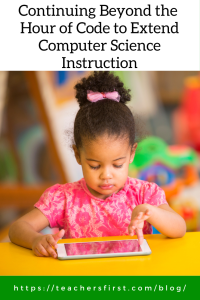Were you among the over 200,000 educators worldwide participating in the Hour of Code this year? This fabulous annual event provides information and inspiration for students of all ages to engage with coding, with no experience required.
The benefits of coding and understanding computer science are well documented. Of all projected new jobs in STEM fields, 67% are in computing, making learning computational skills a necessary part of every curriculum.
In addition to career preparation, understanding coding benefits students in all careers and as a life skill. This article shares 10 Benefits of Coding Beyond the Computer, including persistence, resilience, communication, and problem-solving skills.
The Hour of Code’s (reviewed here) annual celebration focuses on coding activities. Participants worldwide engage in coding activities during Computer Science week each December; however, integrating coding and computer sciences is essential throughout the year.
Integrating coding and computer science throughout the year takes some thought and planning; here are some ideas to help you overcome basic challenges and take advantage of the many benefits of integrating coding and computer science in any classroom.
- Time – There is never enough time to add something new. Consider modifying current content or including direct instruction as a flipped lesson.
- Flipped Learning Lessons – Instead of in-person lessons on different types of coding, introduce the concept as an at-home activity using a video such as What is Coding? Additional ideas for at-home learning include completing practice activities outside the classroom, such as the blocks, HTML, or Javascript tutorials. Learn more from this 3 Cool Tools for Flipped Learning OK2Ask on-demand webinar recording.
- Choice Boards – Include various practice coding activities as part of Choice Board learning options. Additional activity options might include videos about coding careers, such as those found at SciGirls Connect (reviewed here). Learn about creating Choice Boards from these OK2Ask on-demand webinar recordings Engage & Inspire: Choice Boards for Differentiation Part 1 and Engage & Inspire: Choice Boards for Differentiation Part 2.
- Integrate coding activities into your current curriculum. This article contains many examples of converting existing projects into coding projects.
- Professional Knowledge – We aren’t all coding experts, making some educators uncomfortable when bringing coding activities and computer skills into our classrooms.
- Code.org (reviewed here) offers many free professional development online courses for educators of all skill levels. Consider taking the Computer Science Fundamentals module as a starting point. Other attractive options are the Computer Science Connections modules that include lessons for cross-curricular coding activities.
- Become the student. Try the different coding resources found on Code.org for students; start with beginner-level activities in each of the three coding languages and move on to more complex tasks as you develop skills and understanding.
- Lack of Resources – Finding appropriate resources isn’t always easy.
- TeachersFirst Edge Coding Resources – Explore the many free coding resources reviewed on TeachersFirst. Reviews include suggested grade levels and an in-the-classroom section that shares ideas on using and integrating the resource into your classroom.
- Expand your PLN (Personal Learning Network) – Take advantage of the experience and expertise of educators that share ideas on integrating computer science and coding lessons into their classrooms. Here are a few Twitter suggestions to get you started:
- @pcteachershs – Paige Besthoff – Business Education and Digital “TechKnowledgy” teacher
- @codeorg – Code.org – shares coding and computer science lessons and learning activities from classrooms around the world
- @jennasaurustech – Jennifer Mahin – K-5 STEM teacher and tech integration specialist
- @GiftedTawk – Julia’s #STEAMing up Learning! – many ideas and examples of STEM learning in classrooms
- Not in My Curriculum – Coding/computer science isn’t in your curriculum, so how do you include it?
- CS Unplugged (reviewed here) – This resource shares many computer science learning activities that don’t require a computer. Visit the educator’s section to find a list of activities that integrate into many curriculum topics.
- How to Integrate Coding with other subjects – In this video, Kodable shares information on the basics of integrating coding into any topic.
- This article, written by DOD STEM Ambassador Theresa Goltermann, provides timely advice on integrating computer science into K-8 classrooms. Several of the resources shared provide ideas and guidance for integrating computer science into various curriculum areas.
- Hour of Code (reviewed here) – Don’t forget to return to the Hour of Code to find activities integrated into many content areas, including math, science, social studies, language arts, and more.
You might want to reflect on your Hour of Code activities and consider your students’ excitement and enjoyment of coding. Using coding and computer science resources throughout the year rather than just one hour per year is possible with some planning and preparation.
What do you do to bring Hour of Code activities into your classroom? Do you extend learning throughout the year? Share your ideas on bringing computer science and coding into your classroom throughout the school year in the comments below!


